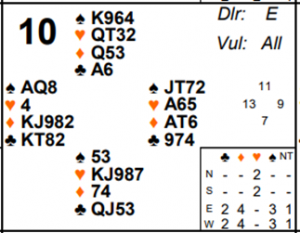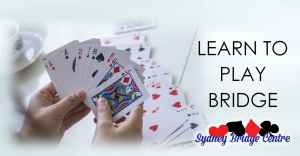City and Canada Bay – Monday Morning 16th September 2024.

On Board 10 last week West faced a decision that’s pretty common. Do you raise partner with only 3 card support or do you bid another suit?
East will pass and so will South unless he has an opening bid available to show a weak hand with hearts and a minor. At that point West has a clear 1♦ opening. Some Norths might consider making a takeout double of 1♦ as they hold both majors. Personally I don’t like double of 1♦ – what do you plan to do when partner bids 2♣ (which will happen a lot in practice)? It’s a matter of style – some pairs basically just double with an opening hand – even if they don’t really have support for all the other suits. Others believe their doubles should be more shape-suitable. As usual, either approach can win on any given hand. Here North doubling will work fine – it will surely cause South to compete to at least 2♥ but East West can bid onto 2♠ or 3♦ easily enough and it’s not at all clear whether North South want to go further.
If North does pass the auction will likely continue 1♠ P back to West. So is West best to raise to 2♠ with only 3, or should he just rebid his 2nd suit with 2♣? Like everything there’s no perfect answer. The downside of raising of course is that partner might be in a 4-3 fit. The upside of raising is that whenever partner has 5 in his suit, it’s likely to be the best suit to play in.
What are some considerations here? Here are some factors that would point me to raising with 3 card support:
- If I have a shortage elsewhere so partner may be able to ruff losers with my 3 card trump holding.
- If my 3 card support is fairly weak (if you have something like KQJ then it may be no good partner ruffing with those as it might just promote trump tricks for the defence – conversely if they are weak trumps then the ruffs are valuable and hopefully partner has better trumps to draw the opponents’).
- If I am a minimum opening bid – so if partner is weak, it’s likely to be the only chance to reach a fit in that suit.
- If my 1st or 2nd suit aren’t that good so I don’t really want partner going back there – or leading them later should we end up defending.
- If I don’t have a 2nd suit I can rebid because it would be a reverse (for example if I had a minimum 1453 shape hand after 1♦ P 1♠ – now I am not strong enough to rebid 2♥ as that forces partner to the 3 level if they need to go back to diamonds – so the only alternatives are to rebid a 5 card diamond suit or raise spades).
- If we have some bidding methods for partner (when he has a good hand) to find out if I had 3 or 4 cards for my raise.
- If we are playing matchpoints and partner’s suit is a major (because majors score so much better – 2 major making is the same +110 as 3 minor; 2 major making an overtrick is +140 which beats 10 tricks in a minor +130).
- How good is partner’s declarer play?! Playing 4-3 fits can be hard!
Personally on this hand I like 2♠ as it means nearly all of these criteria. However, if West chooses to rebid 2♣ then East has an easy 2♦ preference bid and the pair will probably play there. If West chooses to raise to 2♠ then that too will likely end the auction. There are, however, bidding methods available for East to enquire what sort of raise West had – see advanced section for more.
What about the play? Looking first at a diamond contract from West, North will most likely lead a heart. It’s not totally clear how declarer should play. If he gets diamonds right he can end up just losing 1 spade and 2 clubs. But in the real world it’s much harder. I’d probably start with a spade finesse, hoping to end up making at least 3 spades and perhaps discarding at least 1 of my clubs on the ♠J. At worst declarer will probably make 8 tricks (3 spades, ♥A and 4 diamonds).
A spade contract by East is interesting. Playing 4-3 fits sometimes requires a bit of thought. The opponents’ trumps are more likely to split 4-2 rather than 3-3 (see more details in the advanced section) – which means you generally want to avoid being forced to ruff in the long trump hand (now any defender with 4 trumps will have control as they will have more trumps than you). South might lead a heart or the ♣Q. On ♣Q, should declarer cover with ♣K? No – absolutely not! See advanced section for why. A heart is the most challenging defence. What might declarer do after he wins ♥A? Most likely is to take a spade finesse with the aim of later drawing trumps and running diamonds. But how should declarer take the spade finesse – low to the ♠Q or run the ♠J? I’d go for the former on this hand.
If declarer takes a spade finesse it would actually be good defence for North to NOT win ♠K but to instead duck smoothly! If he does win, then declarer is in a position to draw trumps. But if North ducks then declarer might fall into the trap of crossing back to hand with ♦A (his only certain entry to East now ♥A has been knocked out) and run ♠J to repeat what he thinks is a winning finesse. When North wins ♠K on the 2nd round, he has some options. He can play a 3rd round of trumps. That would stop any heart ruffs in dummy and, if declarer fails to get diamonds right, the defence will now be able to cash some hearts. Alternatively North could actually play a heart himself to force dummy (West) to ruff with a trump honour which may promote the ♠9 into a trick in his hand. Either way things could get ugly for declarer.
See advanced section for another non-intuitive way declarer might tackle 2♠ on a heart lead.
Key points to note
- Raising a response with 3 card support can work well – but it’s important for the pair to agree when they do this and if they have subsequent bids to help them identify what the nature of the raise was.
- Minimum opening bids are more likely to want to raise with 3 card support – stronger ones can bid a 2nd suit first and then show delayed support.
- 4-3 fits require care with trump control – having the long trump hand forced to ruff can be fatal!
- As a defender when declarer takes a finesse it can be quite effective to duck smoothly. Declarer may well waste an entry to repeat what he thinks is a winning finesse.
More advanced
After a 1 major response has been raised by opener, a popular method is for responder to use 2NT as an artificial enquiry about the nature of the raise. This is usually done when responder only has 4 of his suit (with 5 he already knows there’s a fit). Reponses are usually something like this:
- 3 major = min with 4 card support
- 4 major = max with 4 card support
- 3 other = natural’ish with 3 card support
- 3NT = flattish with 3 card support
It’s important to discuss whether 2NT is game forcing at this point or not. Either method is playable – but the pair needs to know which! Had the East hand been stronger here, it could have continued with 2NT enquiry after 1♦ – 1♠ – 2♠. West could bid 3♣ which would show his raise was only based on 3 card spade support and he has clubs (or at least values in clubs). Here of course East isn’t remotely strong enough for that and just has to leave 2♠ knowing it might be a 4-3 fit
If a pair does frequently raise on 3 card support then a further useful inference can arise on other sequences. Suppose it goes 1♦ – 1♠ – 2♣ – 2♦ – 2♠? Now opener is showing extra values with 3 spades. Why extra values? Because with a minimum hand and 3 spades he would have raised immediately – instead he has bid his 2nd suit and, over a non-forcing preference bid of 2♦, he has NOW bid 2♠.
When playing a 4-3 fit, trump control is important. The odds are the opponents’ trumps will split 4-2. In isolation 6 missing cards will split 3-3 36% of the time, 4-2 48% of the time and 5-1 or 6-0 16% of the time. Of course that’s just the pure mathematics of a split – in the real world the bidding may well change those odds. If one player has pre-empted for example, it makes it more likely they will be shorter in other suits.
I said if South led ♣Q against a spade contract that East should not cover. Why not? Because how can it gain? No-one in their right mind leads the Q from an AQ holding against a suit contract. So the ♣A is marked with North. Why can’t it be singleton? South could have led from ♣QJxxx. Now the ♣A will hit thin air. In any case, if you don’t cover initially and the ♣Q holds the trick you can always lead towards the ♣10 on the next round which, assuming South has ♣J, will force the ♣A and set up the ♣K anyway.
Playing the spade suit in isolation you might well run ♠J from East. If South has ♠Kxx this will enable it to be picked up and you will remain in the East hand to be able to repeat the finesse. But here it’s a dangerous line because if ♠J loses, then dummy is left with ♠AQ and the defence playing a heart will force declarer to ruff with one of his big trump honours. What declarer really wants to be able to do is take a heart ruff with West’s ♠8 and use the other big spades to help draw trumps. Low to ♠Q could therefore be better as it preserves ♠8 in dummy for a possible heart ruff.
If East is in 2♠ on a heart lead there is another possibility available to him on a heart lead. Counter intuitive though it appears, how about if declarer DUCKS North’s ♥Q?! Dummy’s ♣K is now protected so it’s not that clear what North’s best move now is. If he plays a 2nd heart declarer can ruff it in dummy and now play ♠AQ. If North wins and plays yet another heart declarer still has ♥A and can now draw trumps. Ultimately, however, declarer is probably going to have to get diamonds right to score well and that’s not at all obvious to do. So while it probably won’t help on this hand the technique of ducking an Ace (and appearing to create an extra loser) in order to keep control of the suit for later can be quite powerful.
Julian Foster (many times NSW representative) ♣♦♥♠



